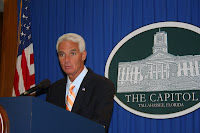
STEINHATCHEE -- The expansive sea grasses in the clear waters off Taylor County wave gently in the currents and shimmering light while occasionally revealing an orange starfish, a blue crab or a clump of gray oysters.
Donning their masks and snorkels, thousands of visitors to the Big Bend each year glide gently over the underwater meadows looking for bay scallops, with their string of sparkling blue eyes looking back amid the lush green sea grasses. Fried or sauteed with pasta, fresh-caught scallops are a Big Bend tradition.
July 1 marks the scalloping season along the northern Gulf Coast and the Big Bend, where scallops are the most plentiful. But scallops also are showing signs of a comeback in Southwest Florida where they also were once more plentiful.
A restoration project involving conservation groups and about 60 families may be helping the scallops increase in numbers but state fisheries officials can't be sure, said Steve Geiger, of the Florida Fish and Wildlife Conservation Commission.
In some of those areas, families tie to their docks cages of scallops that reproduce, sending larvae to settle throughout the area. The scallops are taken from the wild when they are smaller and allowed to mature in saltwater tanks before being placed in the cages.
Scallop populations in Tampa Bay and Sarasota Bay now are approaching healthy levels. In Charlotte Harbor and Pine Island Sound, they're also showing signs of improvement.
"I would like to think the restoration we are doing is speeding up the recovery that would happen naturally," said Geiger, a research scientist in the agency's Fish and Wildlife Research Institute in St. Petersburg.
But there are not enough scallops in South Florida to allow recreational harvesting any time soon, Geiger said. Scalloping now is allowed only from the Pasco-Hernando County line near Aripeka to the Mexico Beach Canal in Bay County.
Scallops historically occupied bays and near-shore waters from Palm Beach to Louisiana. But commercial fishing in the mid-1900s, dredging and filling shorelines and bays and changes in freshwater flow patterns caused by development substantially reduced the range of healthy populations, Geiger said.
Now the focus of recreational scalloping is in the Big Bend and eastern Panhandle where the numbers are most plentiful. There is no commercial harvest of bay scallops in Florida.
Researchers have found more scallops in St. Joseph Bay than last year but fewer in the Big Bend, including Taylor County, and much fewer in areas around Wakulla and Franklin counties, which were among the best areas in the state last year, Geiger said.

Off Steinhatchee in Taylor County, it could take longer for visitors to catch their limits. Geiger said the heavy rains and flooding this year may have resulted in fewer numbers because scallops cannot tolerate much fresh water.
A University of Florida study has shown that scalloping provides a $90 million annual economic impact for Taylor County, said Dawn Taylor executive director of the county's Chamber of Commerce and Tourist Development Council. Details of the study could not be confirmed by FloridaEnvironments.com. She said boat captains are reporting plentiful scallops in some deeper waters.
Scalloping is a clean sport and a fun family activity that allows children to glimpse a lot of sea life that they normally would not get to view, Taylor said. Visitors from Florida cities and surrounding states pack the few hotels and marinas that dot the Big Bend coastline.
"As far as the economy goes, in this area scalloping season is our saving grace," Taylor said. "I know all our motels and marinas along the coast line -- this is their best time of year. They really look forward to it."
Divers and snorkelers must display a "divers-flag" while in the water and they must have a regular Florida saltwater fishing license when using a boat. Starting Aug. 1, a regular license or new shore-based license will be required if wading from shore.
To view an FWCC news release with more details about regulations,
click here.To view an FWCC report with sample results for scallops by region,
click here.
To view an FWCC scientific report on scallops' life history,
click here.
Photos courtesy of the Florida Fish and Wildlife Conservation Commission Fish and Wildlife Research Institute. Story copyrighted by Bruce Ritchie and FloridaEnvironments.com . Do not redistribute without permission.
























